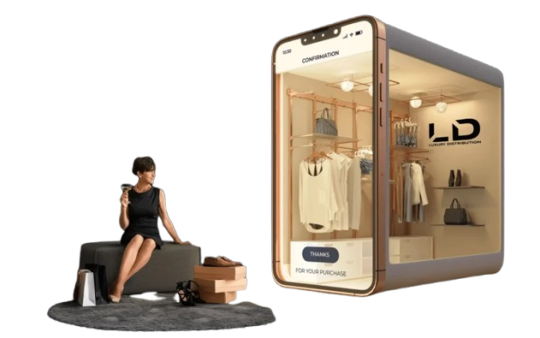#B2B eCommerce Platform
Explore tagged Tumblr posts
Text
B2B eCommerce Platform: Transforming the Future of Wholesale & Enterprise Trade

A B2B eCommerce Platform is no longer a luxury—it's a necessity for wholesale businesses looking to stay competitive in the digital-first economy. From real-time inventory syncing to AI-driven personalization, these platforms empower businesses to automate workflows, reach global markets, and streamline the entire supply chain. As industries move toward digital transformation, a robust B2B eCommerce Platform helps enterprises reduce operational costs, boost scalability, and deliver seamless buyer experiences. Whether you're a distributor, manufacturer, or service aggregator, adopting B2B digital commerce solutions ensures you're future-ready in a world where speed, efficiency, and customization are key to success.
#B2B eCommerce Platform#artificial intelligence#order management software#supply chain management#B2B digital commerce
0 notes
Text

Best Ecommerce Platform for Small Business: A Complete Guide
Starting an online store can be a game-changer for small businesses. However, choosing the Best Ecommerce Platform for Small Business can be overwhelming with so many options available. The right platform should be user-friendly, cost-effective, and scalable to meet future needs. In this guide, we’ll explore the Best Ecommerce Platform for Small Business, covering features, pricing, and benefits. We’ll also compare it with the Top Ecommerce Platforms for Large Business and discuss the Best Ecommerce Platform for Drop-Shipping, platforms with Low Transaction Fees, and B2B Ecommerce Platforms. Choosing the Best Ecommerce Platform for Small Business ensures long-term success, better customer engagement, and improved revenue.
#Best Ecommerce Platform for Small Business#Top Ecommerce Platforms for Large Business#Best Ecommerce Platform for Drop-Shipping#Ecommerce Platform with Low Transaction Fee#B2B Ecommerce Platform
0 notes
Text
Wholesale Ecommerce Platform

Shopaccino, best wholesale ecommerce platform simplifies bulk purchasing and distribution for businesses, making it easy to manage orders, track inventory, and set custom pricing for B2B clients. Shopaccino’s wholesale ecommerce platform offers powerful tools for wholesalers, including credit sales flexibility, personalized account management feature and more. It’s a versatile solution designed to boost efficiency and grow your wholesale operations in today’s competitive market. Check out the entire details at https://www.shopaccino.com/b2b-ecommerce-platform
#Wholesale Ecommerce Platform#Wholesale Ecommerce Platform India#B2b Ecommerce Platform India#Wholesale Ecommerce Software#Best B2B Ecommerce Platform#Ecommerce Platform For B2b#B2b Ecommerce Software#B2b Ecommerce Platform#B2b Ecommerce Solutions
0 notes
Text
Increase Your Sales with B2B Wholesale Software | MarketTime
In today’s business environment, One effective solution to grow your business is B2B Wholesale Software. This software is designed specifically for wholesalers and distributors, offers a range of features and capabilities that can help businesses increase their sales. MarketTime provide this powerful tool that can help businesses increase their sales and simplify their operations. Designed specifically for wholesalers and distributors, this software offers a range of features and capabilities that can help businesses operate more efficiently and effectively. One of the key benefits of this Wholesale Software is its ability to help businesses manage their products more effectively. With this software, businesses can track their stock levels in real-time, set automated re-ordering triggers, and receive alerts when supplies are running low. This can help businesses avoid stockouts and ensure that they always have the products their customers need.
Overall, if you’re looking to increase your sales and simplify your operations, B2B marketplace is a great choice. With its powerful features, this software can help businesses of all sizes achieve their goals and succeed in today’s competitive marketplace.

0 notes
Text
5 Signs You Might Have Sleep Apnea

Introduction: Sleep apnea is a prevalent sleep disorder that often goes undiagnosed, impacting the overall health and well-being of individuals. Being aware of the signs associated with sleep apnea is crucial for early detection and effective management. In this article, we will explore five common indicators that might suggest you are experiencing sleep apnea.
Loud and Persistent Snoring: One of the primary signs of sleep apnea is loud and persistent snoring. While occasional snoring is normal, intense and disruptive snoring can be a cause for concern. If your snoring is accompanied by pauses, gasps, or irregular breathing patterns, it could be indicative of sleep apnea. Partners or family members who observe these patterns should encourage seeking professional advice.
Excessive Daytime Fatigue: Feeling excessively tired and drowsy during the day, despite spending what seems like a sufficient amount of time in bed, may be a red flag for sleep apnea. The interruptions in breathing throughout the night can lead to fragmented sleep, preventing the individual from reaching the deeper, more restorative stages of the sleep cycle. Persistent daytime fatigue should not be ignored and warrants further investigation.
Episodes of Choking or Gasping: Individuals with sleep apnea often experience episodes of choking or gasping for breath during the night. These instances occur when normal breathing resumes after a temporary pause. If you wake up abruptly with a sensation of breathlessness or choking, it is essential to consult with a healthcare professional to assess the likelihood of sleep apnea.
Difficulty Concentrating and Memory Issues: Sleep apnea can impact cognitive function, leading to difficulties in concentration and memory issues. The lack of quality sleep hinders the brain's ability to consolidate memories and perform cognitive tasks effectively. If you find yourself struggling with focus or experiencing memory lapses, it may be linked to sleep apnea, and seeking medical advice is recommended.
Morning Headaches: Frequent morning headaches can be another potential sign of sleep apnea. The intermittent pauses in breathing during the night can result in reduced oxygen levels, triggering headaches upon waking. If morning headaches persist and are accompanied by other signs such as snoring and daytime sleepiness, it is crucial to consult a healthcare professional for a comprehensive evaluation.
Treatment Options for Sleep Apnea:
Once sleep apnea is identified, various treatment options are available to help manage and alleviate its symptoms. The choice of treatment depends on the severity of the condition and its underlying causes. Here are some common approaches:
Lifestyle Changes: Making certain lifestyle modifications can significantly improve sleep apnea symptoms. These may include losing weight, avoiding alcohol and sedatives, changing sleep position, and establishing a regular sleep schedule. Lifestyle changes can be particularly effective for individuals with mild to moderate sleep apnea.
Continuous Positive Airway Pressure (CPAP): CPAP therapy is a widely used and effective treatment for sleep apnea. It involves wearing a mask over the nose or mouth during sleep, which delivers a continuous stream of air to keep the airways open. CPAP is highly successful in preventing the interruptions in breathing that characterize sleep apnea.
Bi-level Positive Airway Pressure (BiPAP): BiPAP machines, similar to CPAP, deliver pressurized air but allow for different pressures during inhalation and exhalation. This can be beneficial for individuals who find it challenging to exhale against the constant pressure of a CPAP machine.
youtube
Adaptive Servo-Ventilation (ASV): ASV devices are designed to monitor breathing patterns and adjust air pressure accordingly. This type of therapy is often prescribed for individuals with complex or central sleep apnea.
Oral Appliances: Dental devices, such as mandibular advancement devices, can be used to reposition the lower jaw and tongue to keep the airway open. These are especially recommended for those with mild to moderate sleep apnea who cannot tolerate CPAP therapy.
Surgery: In severe cases or when other treatments are ineffective, surgery may be considered. Surgical options may include uvulopalatopharyngoplasty (UPPP), genioglossus advancement (GA), or maxillomandibular advancement (MMA). However, surgery is typically reserved for cases where other interventions have proven unsuccessful.
Positional Therapy: Some individuals experience sleep apnea primarily when sleeping in certain positions. Positional therapy involves techniques or devices to encourage sleeping in positions that minimize airway obstruction.
It's important to note that the most suitable treatment will be determined through consultation with healthcare professionals who specialize in sleep medicine. Regular follow-ups and adjustments to treatment plans may be necessary to ensure optimal effectiveness. Seeking timely and appropriate treatment not only improves the quality of sleep but also contributes to overall health and well-being.
1 note
·
View note
Text
Leading B2B e-Commerce for Industrial Products



Grateful for your continued support! 🙏💕 Sharing expert online shopping tips, your engagement means the world. Let's keep this community thriving! 🛍💻 #ThankfulThursday #OnlineShoppingTips #CommunityLove
intags #onlinemarketplaces #manufacturers #wholesaler #apparelmanufacturer #manufacturer #wholesalefashion #distributor #onlinemarketplace #wholesalers #wholesalevendors #b2b #b2bservices #ecommerceexpert #ecommercestore #ecommercebusiness #ecommercewebsite #ecommerceentrepreneur #ecommerce #ecommerceplatform #ecommercesolutions #ecommercemarketing #b2bsales #ecommercedemoda #ecommercedesign #intags #ecommercetips #b2bmarketing #intags #onlineshoppingindia
0 notes
Text

Boosting Sales and Efficiency: B2B Online Ordering Platforms
NetSymm is your gateway to cutting-edge B2B eCommerce platforms. Explore a seamless B2B food and beverage commerce platform that empowers businesses in the food industry. Revolutionize your operations with our user-friendly B2B online ordering platform. Elevate your business efficiency with NetSymm's tailored solutions. Discover the future of commerce with us.
#B2B eCommerce platform#B2B eCommerce platforms#B2B Food and Beverage commerce platform#B2B online ordering platform
0 notes
Text

Find the Best Ecommerce Platform for Small Business in 2025
Choosing the right ecommerce platform is crucial when starting a small business. It forms the foundation of your online store, impacting everything from customer experience to scalability. With so many options available, selecting the best one can feel overwhelming. Key factors to consider include ease of use, customization options, payment integrations, and cost-effectiveness. Your choice should align with your business needs and future growth plans. This blog will guide you through the essential criteria for choosing the best ecommerce platform for small businesses. We’ll also review top platforms to help you make an informed decision. Whether you’re looking for simplicity or advanced features, understanding your priorities will lead you to the ideal solution for your store’s success.
#Best Ecommerce Platform for Small Business#Top Ecommerce Platforms for Large Business#Best Ecommerce Platform for Drop-Shipping#Ecommerce Platform with Low Transaction Fee#B2B Ecommerce Platform
0 notes
Text
Why Automotive Manufacturers are Turning to B2B eCommerce Platforms

Introduction
The automotive world is changing fast—and not just under the hood. As digital transformation accelerates across industries, automotive manufacturers are increasingly jumping on the B2B eCommerce bandwagon. Why? Because it's not just about selling cars anymore—it's about reaching the right buyers, simplifying operations, and staying ahead in a competitive landscape. And that’s exactly what B2B platforms are delivering.
Let’s explore why automotive B2B platforms are becoming a must-have for manufacturers and how companies like Justtry Technologies are making that transition smoother and smarter.
The Shift Toward Digital in the Automotive Industry
The digital revolution hasn’t spared the auto sector. From connected vehicles to AI-powered diagnostics, innovation is everywhere. One of the biggest moves? Shifting sales, parts distribution, and procurement processes to B2B digital commerce platforms.
Expanded Reach Through Digital Channels
Geographic Expansion
Traditional dealerships and distribution networks have limitations.
A B2B automotive marketplace lets manufacturers go global without opening new branches.
Serving New Customer Segments
Now reaching mechanics, fleet managers, and wholesale buyers.
Platforms like BigCommerce highlight the importance of tapping into niche segments.
Enhanced Customer Experience
Convenience and Accessibility
Buyers can explore, compare, and order parts without stepping out of their office or workshop.
Orders placed in minutes, not hours.
Personalization with Data
Using data to recommend the right parts to the right customer.
Custom dashboards, reordering suggestions, and tailored offers.
Faster Order Fulfillment
No more waiting for showroom stock checks.
Automated workflows speed up the buying process.
Streamlined Operations and Lower Costs
Reduced Dependence on Physical Showrooms
Shifting online cuts rent, maintenance, and showroom staff costs.
Greater ROI on digital storefronts.
Smarter Order Management Systems
Bulk order processing.
Live inventory updates reduce human errors.
Automated Workflows and Efficiency
Less paperwork, fewer delays.
Staff can focus on customer support and strategy.
Embracing Automotive Digital Transformation
Integration of Smart Technologies
ERP, CRM, and inventory tools connected in one ecosystem.
Unified backend for smooth operations
Virtual Showrooms and AR Tools
Showcase parts or vehicles in 3D.
Help customers “see” before they buy.
Justtry Technologies – Powering the Shift
At Justtry Technologies, we’re not just keeping pace with the automotive digital revolution—we're helping drive it.
Built for Automotive Manufacturers
Our B2B eCommerce platform is tailor-made for the automotive supply chain. From tier-one manufacturers to independent suppliers, we deliver:
Real-time order management
Bulk pricing and quotation tools
Seamless integrations with logistics and ERP systems
Smarter Auto Parts Distribution
We eliminate the friction in auto parts distribution. Say goodbye to email chains and spreadsheets. With us, it's all automated—from PO to payment.
Centralized dashboard for order tracking
Automated stock updates across channels
Support for multi-warehouse operations
Scale Fast. Sell Smarter. Globally.
Want to expand into new markets? Our platform is designed to grow with you.
Multi-currency and multilingual support
API integrations for shipping, payments, and CRMs
AI tools for dynamic pricing and product bundling
Whether you're shipping brake pads across borders or onboarding new dealerships online, Justtry Technologies helps you do it better, faster, and smarter.
Conclusion
Automotive manufacturers aren’t just adapting to the digital world—they're owning it. With B2B eCommerce platforms, they're not only cutting costs and improving operations, but also creating better, faster, and smarter ways to connect with customers. Whether you’re a parts supplier or a vehicle OEM, the future is digital—and it's already here.
Justtry Technologies is here to help you lead that future.
#B2B automotive marketplace#automotive B2B platforms#automotive manufacturers#automotive eCommerce trends#B2B digital commerce#automotive industry technology#B2B eCommerce for manufacturers#automotive logistics
0 notes
Text

MarketTime is a leading wholesale marketplace that connects buyers and sellers of all sizes. We provide a platform for businesses to access a vast network of suppliers and purchase products at competitive prices. With MarketTime, buyers can browse a wide range of products, including electronics, clothing, accessories, home goods, and more. The platform offers a user-friendly interface, making it easy for businesses to find the products they need and place orders efficiently. We also provide a suite of tools and features to help sellers showcase their products and manage their inventory. MarketTime is the perfect wholesale marketplace to help you grow your business and succeed in today's competitive marketplace.
#wholesale marketplace#wholesale ecommerce platform#b2b ecommerce platform#order management software
0 notes
Text
Is Sleep Apnea Reversible With Weight Loss (How To Do That)

Sleep apnea is a common sleep disorder characterized by pauses in breathing and shallow breaths during sleep. This results in poor sleep quality and daytime fatigue. Fortunately, there are effective treatments available, and for some people, significant weight loss can reverse their sleep apnea entirely. In this comprehensive guide, we’ll look at the connection between weight loss and sleep apnea reversal.
To start, let’s review what exactly sleep apnea is, why it matters, and how weight factors into the condition.
youtube
What is Sleep Apnea?
Sleep apnea occurs when a person's airway becomes blocked during sleep, causing breathing to repeatedly stop and start. There are two main types of sleep apnea:
Obstructive sleep apnea (OSA) - The more common form, caused by airway blockage when the soft tissue at the back of the throat collapses during sleep.
Central sleep apnea - Occurs when the brain fails to properly signal the muscles that control breathing.
People with untreated sleep apnea stop breathing repeatedly throughout the night, often for a minute or longer and sometimes hundreds of times per night. This disrupts the sleep cycle, depriving the body of oxygen and resulting in:
Excessive daytime sleepiness
Morning headaches
Difficulty concentrating
Irritability
Depression
Increased risk of heart disease, high blood pressure, stroke, obesity, and diabetes
Estimates suggest over 22 million Americans suffer from sleep apnea. Unfortunately, as many as 80% of cases go undiagnosed.
The importance of addressing sleep apnea comes down to improving symptoms of daytime fatigue and irritability while reducing long-term health consequences and risks.
There are several effective medical treatment options for sleep apnea which will be covered later in this article. However, an intriguing area of research suggests that weight loss alone could reverse sleep apnea in some obese patients.
How Might Weight Loss Reverse Sleep Apnea?
Multiple studies have shown a correlation between obesity and sleep apnea. It's estimated that over half of those with moderate to severe sleep apnea are obese.
Carrying excess weight, especially around the neck and throat region, can narrow the airway and contribute to airway collapse during sleep. Even a 10% weight loss has been shown to widen the airway and reduce obstructions that block breathing at night.
Losing weight when you have sleep apnea is beneficial for several reasons:
Reduces fat deposits around the neck that constrict the airway.
Decreases inflammation caused by obesity that narrows airways.
Improves sleep quality, giving you more energy to exercise and shed pounds.
Boosts oxygen levels, making weight loss and daily activities easier.
Resolves other obesity-related conditions like high blood pressure.
Let's look closely at the types of sleep apnea and their main causes to understand the role obesity plays.
Understanding Sleep Apnea: Types and Causes
The two main types of sleep apnea work slightly differently but both share a strong link to being overweight.
Obstructive Sleep Apnea Causes
Obstructive sleep apnea occurs when the muscles supporting the soft tissues in the throat relax during sleep, causing the airway to narrow or collapse. Common causes include:
Excess weight - Fat deposits around the neck that obstruct breathing. A large belly can also impede lung expansion.
Large tonsils/adenoids - Enlarged tissues block airflow.
Structural abnormalities - Facial bone structure, enlarged tongue, or uvula that crowds the airway.
Smoking and alcohol - Relaxes throat muscles, exacerbating obstructions.
Central Sleep Apnea Causes
Central sleep apnea is less common and involves the brain's impaired ability to regulate breathing. Contributing factors include:
Heart disorders - Heart failure can cause fluid buildup in the lungs making breathing difficult.
Stroke - Stroke damages areas of the brain affecting breathing signals.
High altitude - Low oxygen levels impair breathing signals from the brain.
Obesity - While less direct, excess weight stresses the cardiovascular system.
As you can see, poor breathing mechanisms are primarily to blame for both types of sleep apnea. However, excess weight clearly exacerbates airway obstructions and can indirectly tax the cardiovascular system.
This explains why weight loss is commonly recommended as an early intervention for sleep apnea, often before trying more invasive treatments. Even losing just 10-15 pounds can open up the airway and provide a major benefit.
Sleep Apnea Symptoms
Being aware of the signs and symptoms is key to getting diagnosed and treated for sleep apnea sooner. Symptoms may include:
Loud, irregular snoring - A major warning sign caused by air turbulence in the restricted airway.
Gasping or choking during sleep - The body reacts to apneic events and hypoxia.
Restless sleep and frequent waking - The body rouses itself during breathing disturbances.
Morning headaches - Caused by oxygen deprivation and sleep fragmentation.
Daytime grogginess - Lack of restorative deeper sleep stages leads to fatigue.
Irritability and mood swings - Due to poor sleep quality and drowsiness.
Difficulty concentrating - Sleep deprivation impairs focus, memory, and thinking.
Frequent urination at night - The kidneys release hormones to regulate oxygen and CO2 levels.
If you experience clusters of these symptoms, especially loud snoring, it's advisable to discuss sleep apnea screening with your doctor.
Now that we've reviewed the basics of sleep apnea and its link to being overweight, let's analyze the research on weight loss providing a reversal of this condition for some patients.
The Relationship Between Weight Loss and Sleep Apnea Reversal
Numerous studies have explored and demonstrated the effectiveness of weight loss for reducing the severity of sleep apnea, and in some cases reversing it entirely through significant weight loss.
Here is an overview of key research on this strategy:
A 2017 analysis of 12 studies found that weight loss led to a decrease in AHI (apnea-hypopnea index) score and oxygen desaturation. These are two important metrics used to assess sleep apnea severity.
A 2011 clinical trial took severely obese patients (BMI >40) with severe OSA who lost 20% of their body weight through diet and exercise. Their AHI scores dropped from a median of 16.2 events/hour at baseline to a median of just 2.2 events/hour after sustained weight loss.
A 2009 study followed bariatric surgery patients who lost an average of 70 pounds. They reduced their AHI by 31 events per hour on average and 62% no longer met the criteria for OSA diagnosis after weight loss.
A 2013 study found that obese patients with OSA who lost just 5-10% of body weight reduced their AHI score by 20 events per hour and significantly improved oxygen blood saturation during sleep.
These and other studies confirm that losing excess body weight, especially around the neck, throat, and abdomen areas, can reduce the frequency of apneic events during sleep and improve respiratory function.
For those overweight individuals where obesity is a main driver of their sleep apnea, substantial weight loss may provide a long-term cure and eliminate the need for ongoing CPAP or other treatments.
How Does Excess Weight Contribute to Sleep Apnea?
To understand how losing pounds can reverse sleep apnea symptoms, let's look at how carrying excess weight negatively impacts breathing during sleep.
Here are three of the main ways obesity contributes to airway collapse and apnea events:
Fat deposits around the neck constrict the airway - Fat accumulation around the neck forms bulky tissues that protrude into the throat and physically narrow breathing passages, especially when throat muscles relax during sleep. Even slim people can have excess throat fat that encroaches on the airway.
Obesity promotes inflammation - Adipose fat cells secrete pro-inflammatory cytokines that damage tissues, including those around the breathing passages. This swelling narrows the airways.
Weight stresses respiratory function - A large belly makes it harder for the diaphragm and lungs to fully expand and contract during breathing. Carrying extra pounds also increases oxygen needs.
As you can see, addressing excess weight directly reduces anatomical and inflammatory factors that promote airway collapse during sleep. This is why substantial weight loss can reverse sleep apnea in people with obesity-related OSA.
How Much Weight Loss is Needed to Treat Sleep Apnea?
Studies show a direct correlation between the amount of weight loss and a reduction in sleep apnea severity. In general, more weight loss equals greater improvements but even losing 10-15 pounds can have a noticeable impact.
Here are some general weight loss guidelines based on research:
Losing 10% body weight - Improves AHI score by 50% on average based on multiple studies.
15% weight loss - Reduces the number of apneic events by about 40%.
20% weight loss - Shown to nearly resolve OSA entirely in obese patients as in the 2011 study above.
Based on these benchmarks, an effective Weight Loss Strategies for Sleep Apnea Patients
Losing weight is challenging for anyone, and people with sleep apnea face the added hurdle of extreme fatigue and low energy. However, several strategies can help you successfully shed excess pounds to treat sleep apnea:
Focus on dietary changes - Reduce calories by filling up on fruits, vegetables, lean proteins, whole grains, and healthy fats. Avoid added sugars and trans fats.
Increase daily activity - Start slow and work up to 30-60 minutes of moderate exercise like walking 4-5 days a week.
Incorporate strength training - Building muscle boosts metabolism to burn more calories. Shoot for 2-3 strength sessions per week.
Consider weight loss medication - Medications like Phentermine or Qsymia combined with lifestyle changes can aid weight loss. Consult your doctor.
Try intermittent fasting - Restricting eating to set hours like 8 am-6 pm helps reduce calorie intake.
Get support - Having an accountability partner, sleep specialist or registered dietitian helps you stay motivated.
Focus on sleep hygiene - Sticking to a schedule, limiting screens before bed, and creating a restful sleep environment will give you the energy to keep losing weight.
Join a program - Structured programs like Weight Watchers provide guidance, resources, and community support.
Limit alcohol - Alcohol is high in empty calories and disrupts sleep, sabotaging weight loss efforts.
Stay patient and consistent - Losing 1-2 pounds per week in a healthy, sustainable way leads to better long-term results.
Making dietary changes should be the foundation of any weight loss approach for sleep apnea. Combining this with some added activity, following an intermittent fasting protocol, or joining a structured program can help the pounds come off safely and effectively.
Other Treatment Options for Sleep Apnea
If you have mild to moderate OSA, focusing on weight loss first makes sense. However, for more severe cases, other treatment options should be considered concurrently and not delayed. Common medical treatments include:
Continuous Positive Airway Pressure (CPAP)
CPAP is the most effective and common treatment for moderate and severe sleep apnea. It uses a bedside machine and face mask to deliver constant airflow that keeps airways open during sleep. It can immediately resolve apnea events and daytime fatigue. Weight loss can sometimes allow patients to lower CPAP settings or stop use altogether if they lose enough weight.
Oral Appliances
Custom-made oral devices are an option for mild OSA cases or when CPAP machine is not tolerated. These appliances hold the lower jaw and tongue slightly forward to open up the airway. They are less consistently effective than CPAP but work for some patients. Weight loss and oral appliances can be used together.
Surgery
For those with an anatomical obstruction like enlarged tonsils, deviated septum, or small lower jaw, surgery may be recommended to remove or correct these issues enlarging the air passage. Weight loss after surgery helps prevent the recurrence of obstructions.
Other conservative treatments like positional therapy to avoid sleeping on your back or certain medications have also been used as adjunct treatments to help manage mild OSA.
The bottom line is that CPAP and oral appliances provide the fastest relief of apnea symptoms. However, for obese patients, combining these with ongoing weight management provides long-term resolution of the root issue.
Putting It All Together: Takeaways for Reversing Sleep Apnea Through Weight Loss
Let's review the key points:
Sleep apnea is correlated strongly with obesity - Excess weight promotes airway collapse and breathing disturbances during sleep. Even modest weight loss can open up airways.
Research confirms weight loss reduces sleep apnea severity - Notably, those who lost 20% or more of body weight saw the greatest improvements in sleep study results.
Dietary changes combined with added activity/exercise - This is the healthiest approach for sustainable weight loss over months and years.
Conventional medical treatments - CPAP, oral appliances, and surgery help manage sleep apnea faster as you work on losing weight.
Gradual, moderate weight loss is best - Aim to lose 10% of body weight as an initial goal which can significantly decrease the severity of sleep apnea. Even small amounts of weight loss improve symptoms.
Consistency and patience are key - Steady, modest weight loss each week leads to optimal long-term results.
Seek support and sleep hygiene - Getting help from professionals and prioritizing healthy sleep makes weight loss more feasible.
While not a cure-all, intentional weight management paired with standard medical therapies provides the best odds of reversing sleep apnea or putting it into remission for obese patients. As always, it’s critical to work with your physicians throughout the process.
Conclusion
Sleep apnea is a highly treatable condition with various effective options available based on severity. For overweight and obese individuals, targeted weight loss should be part of the treatment plan whenever possible.
Research clearly demonstrates that even losing a modest amount of excess weight can reduce apneic events, improve oxygenation at night, enhance sleep quality, and ultimately reverse sleep apnea in many cases.
While it requires commitment and perseverance, incorporating healthy dietary strategies, activity, sleep hygiene, and ongoing medical care can set you on the path to potentially resolving your sleep apnea through weight loss and a healthier lifestyle.
#b2bmarketing#sleep apnea#cpap machine#b2b ecommerce platform#lose weight#weight loss#snoring treatment#Youtube
1 note
·
View note
Text
youtube
NetSymm: Unleash the Future of B2B eCommerce Platforms NetSymm is a cloud-based B2B eCommerce platform that connects businesses to their suppliers and customers globally. NetSymm automates sales and procurement processes and provides visibility across the supply chain. Customers can place orders from anywhere, anytime using a simple Amazon-like shopping experience.
0 notes
Text
#B2B Platform in India as well as global#Best B2B Marketplace in India#Best B2B Portal in India#b2b services#b2b lead generation#wholesaler#ecommerce#b2bsales#b2b
0 notes
Text
How Benefit Ecommerce Powers Automotive B2B Success

Introduction
The automotive industry is undergoing a dramatic shift, driven by intensifying competition and complex supply chains. Traditional B2B sales processes, reliant on manual workflows and phone calls, are too slow and inefficient. Manufacturers, suppliers, and distributors face pressure to streamline operations, reduce costs, and meet rising buyer expectations for fast, transparent, and flexible service.
B2B ecommerce is stepping in as a critical business enabler, offering real-time inventory access, simplified large-scale orders, and improved buyer experience. By adopting ecommerce, companies can overcome pain points, unlock new growth opportunities, and lead the future of automotive sales. Whether selling auto parts online or expanding into global markets, ecommerce is no longer optional – it's essential.
In this blog, we’ll explore how B2B ecommerce is transforming the automotive industry, what benefits it delivers, and why companies that adopt it now will lead the future of automotive sales.
Why B2B Ecommerce is a Game-Changer in Automotive
The B2B environment within the automotive sector is intricate. Suppliers, wholesalers, OEMs, and dealers require precise data, rapid ordering, and effortless logistics. Ecommerce websites serve these requirements with precision.
Important reasons why B2B ecommerce is important:
Effective Supply Chains: Automated ordering and real-time inventory updates eliminate downtime and manual errors.
Customer Expectations: Buyers expect the same seamless digital experience they have in B2C shopping.
Data-Driven Sales: Ecommerce websites provide insights that help customize offerings, enhance pricing, and predict demand.
By going digital with car sales, businesses eliminate reliance on slow, antiquated processes and build quicker, more precise business transactions.
Major Advantages of Ecommerce for Automotive B2B
Efficient Ordering Process
A car parts ecommerce platform does away with emails, phone calls, or paper trails. Everything is online and available from a single source.
Online catalogs with real-time inventory
Automated billing and payment facility
24x7 self-service portals for bulk buyers
Larger Market Size
Your market is no longer geographically confined with ecommerce. You can engage with clients based in different cities, countries, or even continents.
Multi-lingual and multi-currency support
Mobile-optimized websites for on-the-move orders
Integration with worldwide logistics partners
Enhanced Customer Experience
If B2B buyers receive what they want efficiently and correctly, they stay. Ecommerce ensures their experience is hassle-free and effortless.
Customized dashboards and prices
Live chat, AI support, and real-time order tracking
Simple product search with enhanced filters
Real-Life Example: Auto Parts Distributor Goes Digital
A mid-sized auto parts wholesaler was processing orders via spreadsheets and phone calls. Delays and stockouts were frequent. After going live with a B2B ecommerce platform, they:
Improved order accuracy by 60%
Cut manual processing time in half
Increased monthly sales by 35%
Their customers adored the convenience of logging in, viewing product inventory, accessing prior orders, and monitoring shipments in real time. That's automotive ecommerce power in action.
A B2B Automotive Ecommerce Platform: Must-Haves
To thrive here, your ecommerce platform must satisfy the distinct demands of car sales.
Bulk Order Capabilities: Designed for volume, repeat-buying B2B customers
Integration with ERP/CRM: Smooth workflow between your backend systems
High-Detail Product Specs: Images, part numbers, compatibility information, etc.
Selecting a platform designed for automotive B2B marketplace requirements guarantees scalability, flexibility, and performance.
Next-Ecommerce Trends in Automotive
Stay ahead by being ahead of the curve. Here's what's hot:
AI-Powered Search: Assisting users in finding parts quicker through predictive search and filters
Augmented Reality (AR): Virtual product trials or fitting tools for car parts
Data Analytics Dashboards: Intelligent reporting to improve sales decisions and stock planning
These trends look toward a smarter, quicker, and more customer-centric ecommerce for the automobile industry.
Conclusion
Transitioning into digital is not a luxury anymore—it's a necessity. How ecommerce drives automotive B2B success lies in the capability to deliver today's speed, precision, and convenience requirements.
If you’re an OEM, supplier, or distributor in the auto sector, now is the time to invest in an ecommerce platform. It’s the most effective way to enhance efficiency, improve customer relationships, and boost your bottom line.
B2B ecommerce is not just about selling online—it’s about building a smarter, stronger business. So, gear up and drive your business forward with the right digital tools.
#automotive B2B marketplace#B2B automotive solutions#ecommerce platform for car parts#automotive ecommerce#B2B ecommerce#automotive sales#ecommerce for auto industry
0 notes
Text
#wholesale marketplace#b2b branded commerce#b2b ecommerce platform#markettime#b2b wholesale software
0 notes
Text
The Importance of Marketplace Integration for Designer Brand Suppliers: Luxury Distribution’s Approach
In today’s fast-paced digital world, businesses are constantly looking for new ways to streamline their operations and reach more customers. One of the most effective solutions for designer brand suppliers is marketplace integration. Luxury Distribution, a leading supplier of premium designer brands, understands the power of marketplace integration and is dedicated to helping retailers and suppliers maximize their potential in the competitive fashion industry.
What is Marketplace Integration for Designer Brand Suppliers?
Marketplace integration for designer brand suppliers refers to the process of connecting a supplier’s inventory and order management systems with popular e-commerce platforms such as Amazon, eBay, or other niche fashion marketplaces. This integration allows suppliers to manage their products, pricing, and orders across multiple platforms from a centralized system, ensuring consistency and accuracy across all sales channels.

For designer brand suppliers like Luxury Distribution, marketplace integration simplifies the process of listing and selling products online, while also making it easier for retailers to access and sell premium products from top-tier brands.
Streamlined Inventory Management
One of the key benefits of marketplace integration for designer brand suppliers is efficient inventory management. Without integration, suppliers may struggle to keep track of stock levels, especially when selling across multiple platforms. Manual updates can lead to errors, stockouts, or overselling, which can negatively impact both the supplier and the retailer’s reputation.
By integrating with major marketplaces, Luxury Distribution ensures that inventory levels are updated in real-time, so retailers can always access the most accurate product availability. This reduces the risk of miscommunication and enhances the overall efficiency of the supply chain, making it easier for retailers to manage their product offerings and provide a seamless customer experience.
Increased Reach and Sales Potential
Marketplace integration for designer brand suppliers opens up new opportunities to expand your customer base. By connecting with multiple online marketplaces, suppliers like Luxury Distribution gain access to a global audience of potential customers. These platforms attract millions of visitors every day, many of whom are actively searching for high-quality designer items.
For designer brands, this integration allows them to capitalize on the existing traffic of these marketplaces while also providing the tools necessary to manage their online presence effectively. Retailers benefit by gaining access to a wider range of products from reputable designers, enhancing their own inventory with premium goods that customers desire. As a result, the potential for increased sales and visibility grows exponentially.
Conclusion
Marketplace integration for designer brand suppliers is essential in today’s digital retail environment. For Luxury Distribution, it represents an opportunity to enhance inventory management, increase sales, and offer a seamless experience for both retailers and customers. By embracing the power of marketplace integration, suppliers can scale their operations, reach new customers, and improve their competitive edge in the luxury fashion market. Whether you are a designer brand supplier or a retailer, integrating with popular marketplaces can unlock new opportunities and drive business growth in the fast-paced world of online commerce.
#marketplace integration for designer brand suppliers#marketplace integration#designer brand suppliers#ecommerce integration#multi channel retail#brand management#supplier marketplace#omnichannel integration#b2b marketplace integration#supply chain optimization#e commerce platform integration#designer Brands wholesale#designer brand Drop shipping#designer brands dropshipping#designer brands drop-shipping
0 notes